The genus Calathea has about 130 varieties of plants that can be found in natural conditions in South and Central America. The name of the flower in the literal translation means "basket". This is due to the fact that several centuries ago baskets were woven from the leaves of calathea. Today, the plant has become widespread due to the decorative foliage, which fascinates with attractive patterns.
Calathea is very demanding in care and is famous for its capriciousness and choosiness, so growing a beautiful, healthy plant at home is not so simple. Beginners are not advised to grow this plant, since only an experienced grower can cope with this task.
Content
Characteristics of the variety and species diversity of calathea
Most plant species form surface roots, from which a short trunk grows, which is clearly visible in the photo. The internodes are so close to each other that it seems as if a rosette of leaves is forming right in the soil.
On rather long petioles, large oval-shaped leaves are located. Their length can reach 40 cm. The height of the bush varies between 70-90 cm. Flowering is inconspicuous, but some species, for example, Saffron and Varshevich, have decorative bracts of pink, white, orange or cream color.
The following varieties are grown as home culture:
- Calathea Bahema is considered a relatively unpretentious species. A distinctive feature of the species is the absence of stems. Long leaves (about 40 cm) have a lanceolate shape. The leathery foliage is painted silver-green with a rich green pattern that runs along the length of the middle vein.

Calathea Bachem - Kaloya Makoya can reach a height of 50 cm. Wide-oval foliage grows no more than 20 cm in length. Whitish leaves with light green veins and dark green stripes.
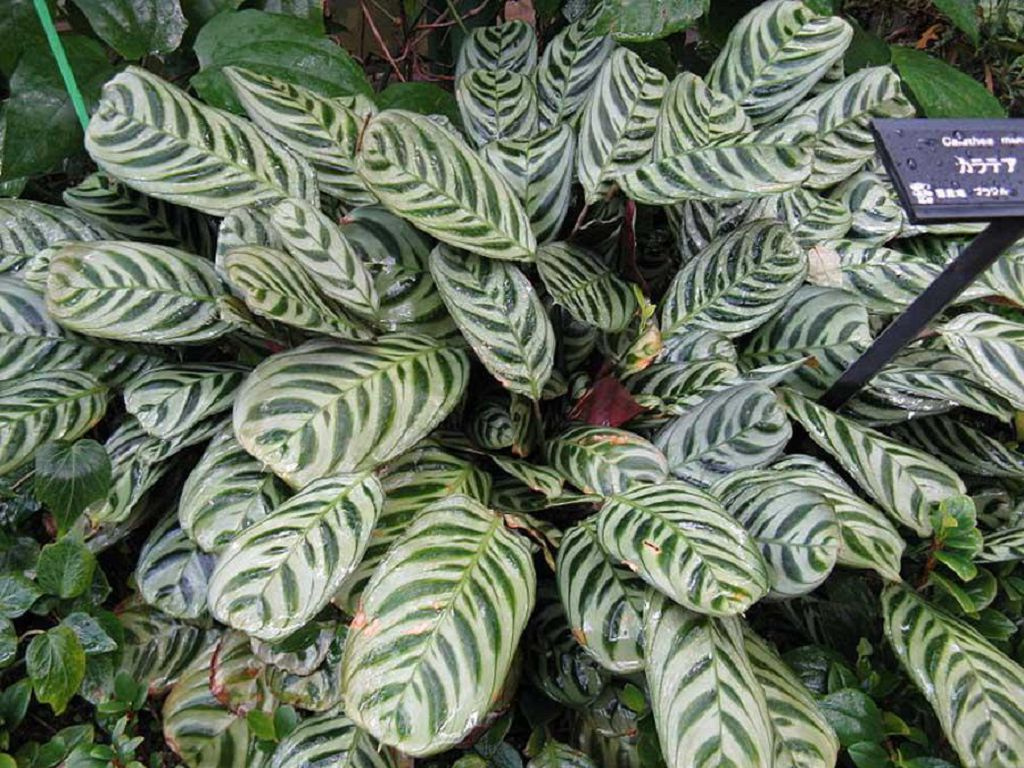
Calathea Makoya - Painted calathea has a thick rosette of elongated leaves, which are surrounded by a dark green border around the contour. The middle of the foliage is painted pale green, almost white. Light green veins are located along the entire length of the leaf.
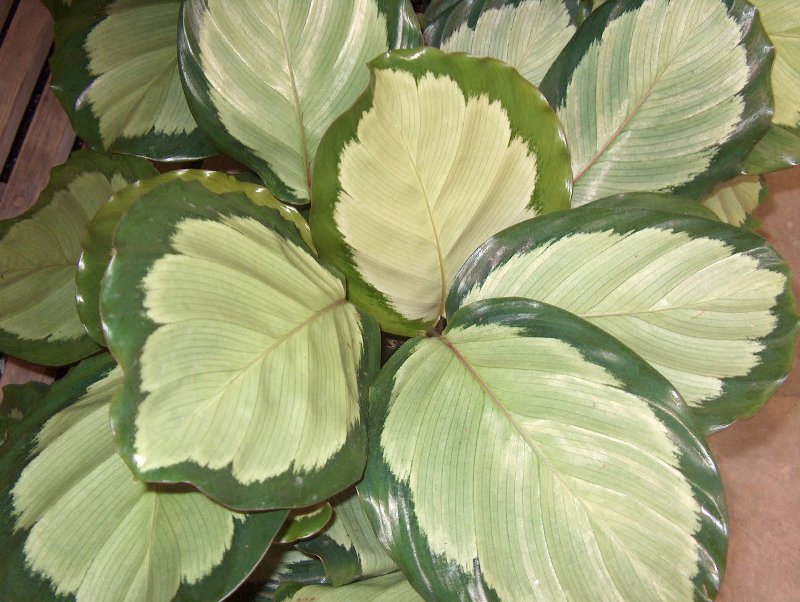
Calathea painted - Calathea Veitch is one of the most beautiful species of this genus. A large plant forms leaves of green shades with a beautiful and unusual pattern of white-green color. The underside of the foliage has a reddish tint.
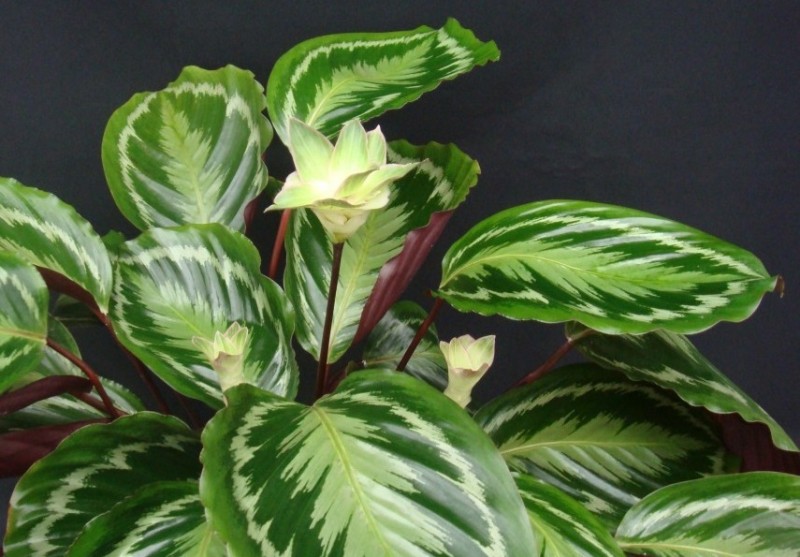
Calathea Veitch - Saffron calathea differs from its relatives in beautiful flowering. With full lighting, this variety blooms orange or bright yellow inflorescences in mid-winter. The foliage is dark green and the lower part has a dark, almost olive hue.
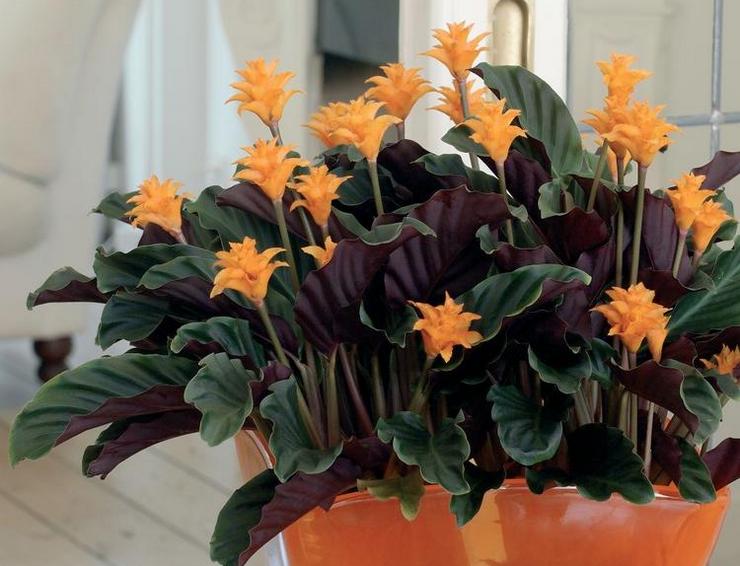
Saffron Calathea
The difficulties of caring for calathea at home
The beauty of the leaves of the bush is mesmerizing, but you should not buy a plant if it is not possible to give it a lot of attention and create optimal conditions. Moody calathea requires ideal conditions of detention, so you should familiarize yourself with her preferences.
Landing soil
The further development and condition of the flower depends on the proper selection of the soil mixture. The flowerpot should be filled with nutritious, loose and sour soil.Alkaline soils have a detrimental effect on the flower, so it is best to purchase a ready-made substrate for arrowroot. You can independently make a soil mixture of the following components:
- humus - 1 part;
- sheet land - 1 part;
- peat - 1 part;
- river sand (calcined) - 0.5 parts.
Lighting
In natural conditions, the flower lives under the crowns of trees, which create protection against scorching rays. At room content, the plant must be shaded from direct sunlight. A small partial shade or a room with diffused light - ideal conditions for growing.
However, a lack of light provokes a change in the color of the leaves, they become pale and lose their decorative effect. An excess of the sun often causes yellowing of the foliage. The flowerpot should be placed on the west, east or south-east side. For good growth, the plant is provided with a 14-hour light day, often using phytolamps.
Temperature and humidity
The temperature of the room where the plant lives should be the same, without sudden changes.
If in winter the flowerpot stands on the windowsill, then it is advisable to place a dense piece of fabric under it, which will protect the root system from hypothermia.
The flower prefers high humidity, about 70%. At home, maintaining such a microclimate is very difficult, so the plant is often grown in a terrarium or florarium. If the flowerpot is on the windowsill, then regularly spraying the space around the flower and only slightly spray the leafy part.
Florists are advised to wipe the foliage more often with a damp cloth, because drops of water can provoke the appearance of dark spots. For species with velvet leaves, another source of moisture should be created - take a small tray, pour expanded clay or pebbles into it, and fill it with water. The flowerpot is placed on stones so that its bottom does not touch the water.
Watering
Water the calathe so that the substrate is constantly wet. Even a slight drought contributes to the death of the plant.
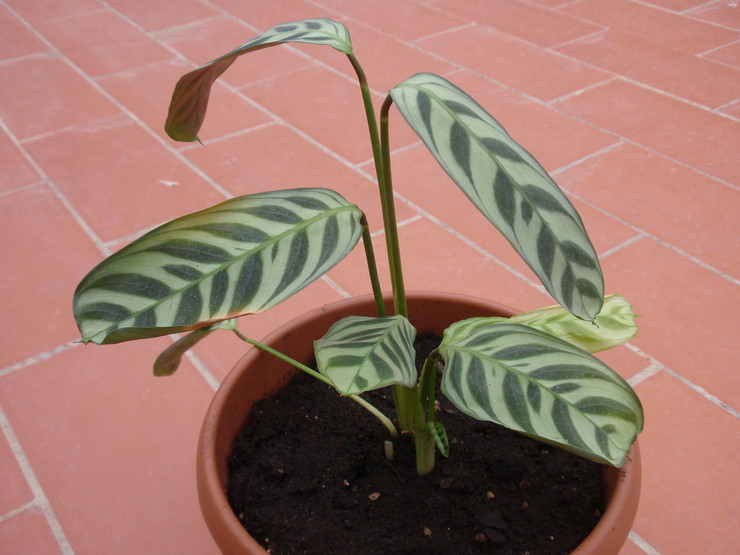
For irrigation take only warm water, which contains a small amount of lime and salts. It is best to use melt or rain water. When watering a flower with tap water, it must first be defended for at least three days. It is advised to put a little peat wrapped in gauze in the settled liquid overnight. This contributes to the acidification of water.
Top dressing
During active development, liquid top dressing intended for decorative-leafy varieties should be applied. The frequency of top dressing should not exceed twice a month, because capricious calathea is very sensitive to an overabundance of nutrients.
Transfer
Young plants are transplanted annually after the end of winter, and adults are disturbed no more than once every three years. To begin with, they select a suitable flowerpot, which should be wide, but not deep. The reaction of the soil intended for planting should be slightly acidic.
After extracting the flower from the old flowerpot, a thick layer of high-quality drainage is poured into the new container, then a layer of freshly moistened soil. After this, the plant is transferred to a new pot by transshipment. This should be done very carefully so as not to damage sensitive roots.The resulting voids are covered with a new substrate and slightly compacted.
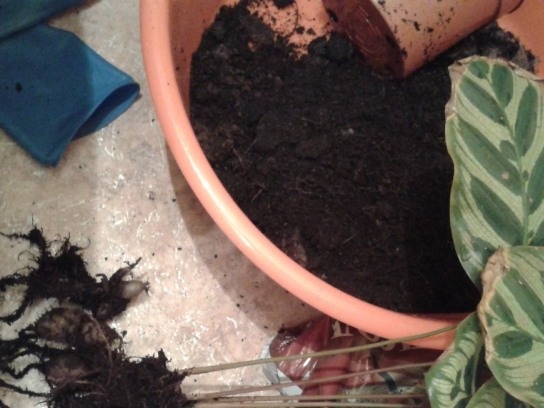
Flower propagation methods
Calathea is difficult to reproduce, but with the desire and proper care of planting material, you can get a new plant. There are three methods of reproduction: dividing the bush, cuttings and using seeds.
Cuttings
Propagate the flower using cuttings, preferably in the spring. Cuttings from an adult plant are cut, the length of which should be within 15 cm. Planting material should have several leaves and growth points. You can also cut the sheet, which, like the stalk, is planted in a separate container with a moist substrate and covered with a transparent film or a plastic bottle.
Bush division
This is the most common method of reproduction, which is carried out during transplantation. The plant is removed from the flowerpot and the rhizome is cut with a sharp sterile knife so that several full-fledged specimens with leaves and roots are obtained.
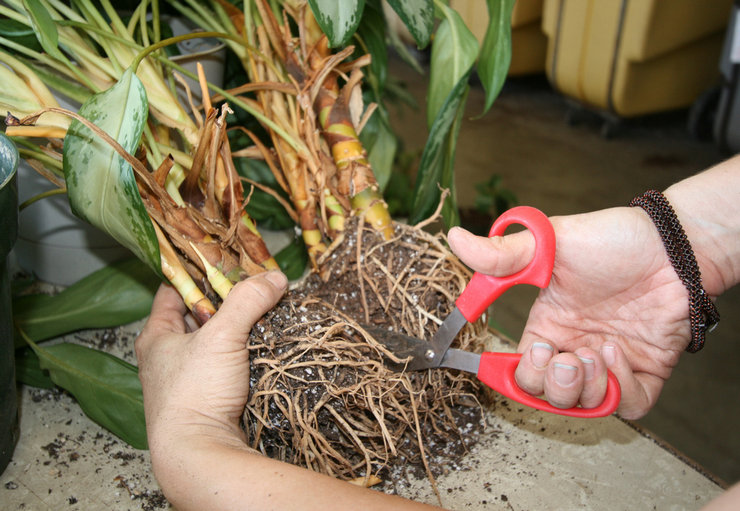
The optimum temperature is + 22-24 ° C. Watering and spraying should be carried out regularly and keep the flowerpot in partial shade. Fertilize once every three weeks.
Seeds
The seed propagation method is the most difficult, because planting material has a short shelf life and poor germination. Sow seeds in a mixture of sand and sheet earth. They are slightly buried in the ground and covered with a film.
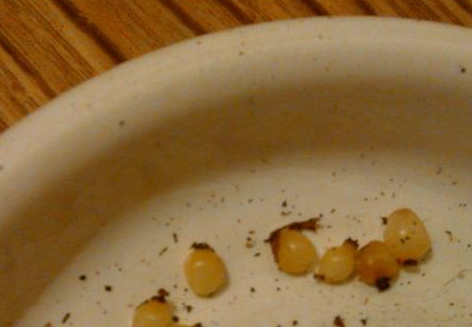
The capacity is transferred to a warm room with a temperature of at least + 22 ° C. Sprouts can be expected one month after planting.
Why do the leaves of calathea dry?
Drying foliage often indicates improper care. The following factors can cause leaves to dry:
- changing the location of the pot;
- wrong watering mode;
- too much capacity for the measles system;
- hit by scorching sunlight;
- hypothermia due to draft;
- low environmental humidity.
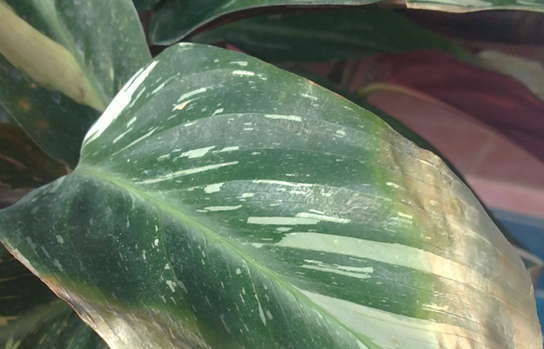
If its tips began to dry out, the humidity in the room is too low. Curled into a tube sheet plates indicate an overabundance of lighting. Darkening leaves indicate rare watering, and blackening stems - the result of heavy watering.
Diseases and their treatment
It is very difficult for beginners to grow calathea, which reacts sharply to improper conditions of detention. Excessive watering can provoke the development of root rot. In this case, it is necessary to transplant the flower, cutting off the damaged areas of the roots, treat with fungicide and get used to the optimal watering.
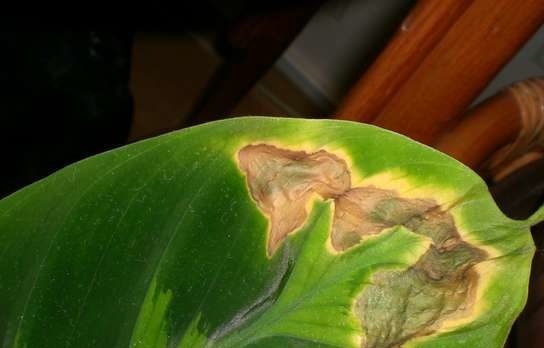
The appearance of brown spots indicates sunburn, so you should change the location of the pot or shade it. If the upper leaves turn yellow - there is an excess of fertilizers in the soil, low room temperature or improper watering.
Pests and control methods
Ticks, thrips and scale insects love the low humidity of the environment, therefore they attack plants that live in such conditions. The affected flower begins to turn yellow and discard foliage. Detect insects most often on the inner side of the leaf. When thin white cobwebs, sticky plaque or whitish dots appear on the aerial parts on sheet plates, it is immediately necessary to take measures:
- The spider mite is destroyed by processing the insecticidal agent in several steps.
- You can get rid of scabs and thrips with the help of a soap solution that processes the plant.
After each treatment, the aboveground part is washed with warm water.
Common Growing Questions
Calathea is famous for its capricious character, but its beauty simply captivates flower lovers. It requires a lot of attention and is demanding on the conditions of detention, but decorative leaves with an intricate pattern will be an excellent reward for chores.




 10 beautiful annuals that bloom all summer
10 beautiful annuals that bloom all summer Sow in the ground, without seedlings: 10 beautiful and unpretentious flowers
Sow in the ground, without seedlings: 10 beautiful and unpretentious flowers Platicodon planting and outdoor care
Platicodon planting and outdoor care Hosta - planting and care in the open ground in the Urals
Hosta - planting and care in the open ground in the Urals